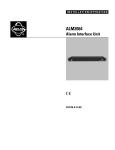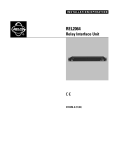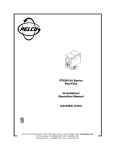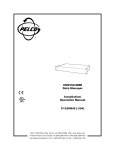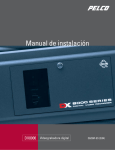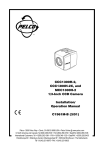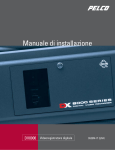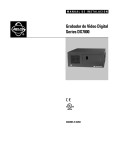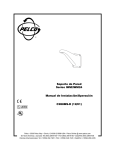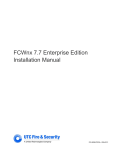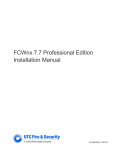Download Installation/Operation
Transcript
® Installation/Operation KBD300A Universal Keyboard C527M-K (9/03) Pelco • 3500 Pelco Way • Clovis, CA 93612-5699 USA • Pelco Online @ http://www.pelco.com In North America and Canada: Tel (800) 289-9100 or FAX (800) 289-9150 • DataFAX (800) 289-9108 International Customers: Tel +1 (559) 292-1981 or FAX +1 (559) 348-1120 • DataFAX +1 (559) 292-0435 PelcoEurope BV • Dillenburg Center, Dillenburgstraat 7C • 5652 AM Eindhoven • The Netherlands Tel +31(40) 251-9870 • FAX +31(40) 251-9835 [2] Pelco Manual C527M-K (9/03) CONTENTS Section Page IMPORTANT SAFEGUARDS AND WARNINGS ........................................................................................ 5 Regulatory Notices ............................................................................................................................ 5 DESCRIPTION ........................................................................................................................................... 6 INSTALLATION – CM6700 MODE .............................................................................................................. 9 Connecting a Keyboard to the Local Keyboard Port ......................................................................... 9 Connecting Keyboards to the Remote Keyboard(s) Port .................................................................. 9 INSTALLATION – CM6800 MODE ............................................................................................................ 11 Connecting KBD300A Direct-Powered Keyboards ......................................................................... 11 Connecting KBD300A Remote Keyboards ...................................................................................... 13 INSTALLATION – CM6700 ASCII MODE ................................................................................................. 15 RS-232 Interface (CM6700) ............................................................................................................ 15 RS-422 Interface (CM6700) ............................................................................................................ 17 INSTALLATION – CM6800 ASCII MODE ................................................................................................. 19 RS-232 Interface (CM6800) ............................................................................................................ 19 RS-485 Interface (CM6800) ............................................................................................................ 21 INSTALLATION – DIRECT MODE ............................................................................................................ 24 Connecting the Keyboard ............................................................................................................... 24 SWITCH SETTINGS ................................................................................................................................. 26 PROGRAMMING AND OPERATION ........................................................................................................ 27 Scanning Functions ......................................................................................................................... 31 Programming Limit Stops ................................................................................................................ 32 Zones .............................................................................................................................................. 33 SPECIFICATIONS .................................................................................................................................... 34 WARRANTY AND RETURN INFORMATION ........................................................................................... 35 Pelco Manual C527M-K (9/03) [3] List of Illustrations Figure 1 2 3 4 5 6 7 8 9 10 11 12 13 Page KBD300A Applications ...................................................................................................................... 8 Wiring Diagram for Local/Remote Keyboards ................................................................................. 10 Keyboard Cabling Diagram ............................................................................................................. 10 Data Cables Plugged into COM 5 and 6 (CM6800-48X8 Shown) .................................................. 12 Connecting Remote Keyboards (CM6800-48X8 Shown) ................................................................ 14 RS-232 Interface Connections (CM6700) ....................................................................................... 16 RS-422 Interface Connections (CM6700) ....................................................................................... 18 RS-232 Interface Connections (CM6800-48X8 Shown) ................................................................. 20 RS-485 Interface Connections (CM6800-48X8 Shown) ................................................................. 22 COM Port Connections and RJ-45 Connector Pin-Outs ................................................................. 23 Direct Keyboard and Receiver Wiring ............................................................................................. 25 Keyboard Rear Panel ...................................................................................................................... 27 Keyboard Functions ........................................................................................................................ 30 List of Tables Table A B C D E F G H [4] Page KBD300A Operational Features ........................................................................................................ 7 Keyboard Addresses ....................................................................................................................... 26 Keyboard Modes ............................................................................................................................. 26 Keyboard Functions ........................................................................................................................ 27 KBD300A Button Functions ............................................................................................................. 30 Operating Scan Functions with Various Receivers ......................................................................... 31 Limit Set Codes ............................................................................................................................... 32 Zone Programming Procedure ........................................................................................................ 33 Pelco Manual C527M-K (9/03) IMPORTANT SAFEGUARDS AND WARNINGS Prior to installation and use of this product, the following WARNINGS should be observed. � Installation and servicing should only be done by qualified service personnel and conform to all local codes. � This unit is designed for indoor use only, and it must not be installed where exposed to rain and moisture. � Only use replacement parts recommended by Pelco. � After replacement/repair of this unit’s electrical components, conduct a resistance measurement between line and exposed parts to verify the exposed parts have not been connected to line circuitry. Please thoroughly familiarize yourself with the information in this manual prior to installation and operation. REGULATORY NOTICES This equipment has been tested and found to comply with the limits of a Class A digital device, pursuant to part 15 of the FCC rules. These limits are designed to provide reasonable protection against harmful interference when the equipment is operated in a commercial environment. This equipment generates, uses, and can radiate radio frequency energy and, if not installed and used in accordance with the instruction manual, may cause harmful interference to radio communications. Operation of this equipment in a residential area is likely to cause harmful interference in which case the user will be required to correct the interference at his own expense. Pelco Manual C527M-K (9/03) [5] DESCRIPTION The KBD300A Universal Keyboard can be used in numerous operational modes: CM6700 Mode: Program and operate the CM6700 Matrix Switcher/Controller Unit (SCU). Also control a Genex® multiplexer from a CM6700. Multiple keyboards can be used in this mode. CM6800 Mode: Program and operate the CM6800 Matrix Switcher/Controller Unit (SCU). Also control a Genex multiplexer from a CM6800 SCU. Multiple keyboards can be used in this mode. Direct P Mode: Control up to 16 receivers connected directly to the keyboard. A separate system, such as an MS500 or VA6100 Switcher, is needed to route video to the monitor. NOTE: The KBD300A keyboard can also be used in Direct Mode to program a CM9760-MDA Master Distribution Amplifier. Refer to the CM9760-MDA manual for details. NOTE: The KBD300A keyboard has an auto-centering joystick. Be certain the joystick remains in the neutral (vertical) position as power is applied to the keyboard. Do not move or hold down the joystick until after the red digit LEDs have finished flashing the firmware revision. The latest firmware release (version 5.00) allows three additional modes: CM6700 ASCII Mode: This mode supports the CM6700 matrix auxiliary commands. The F1, F2, and F3 keys control the CM6700-MXB relays that are on the matrix bay. To enable this mode, DIP switch 7 must be ON and DIP switch 8 must be OFF. CM6800 ASCII Mode: This mode supports the CM6800 GPI commands. The F1, F2, and F3 keys control the relays on an REL2064 that is connected to a CM6800 switcher. To enable this mode, DIP switch 7 must be ON and DIP switch 8 must be ON. Direct D Mode: This mode is similar to the Direct P Protocol, except that the same set of commands is now sent in Direct D Protocol. To enable Direct D mode, DIP switches 5 and 7 must be ON. NOTE: You must upgrade your KBD firmware to version 5.00 if the application requires you to select two-digit monitor numbers. [6] Pelco Manual C527M-K (9/03) Table A. KBD300A Operational Features Function CM6700/ Direct CM6800 P* CM6700 CM6800 ASCII** ASCII** Automatically recognize the mode Yes Yes No Select cameras (control only for Direct Mode) Yes Yes Select monitors Yes No Control lenses Yes Set and call presets/patterns Create Zones Direct D** No No Yes No Yes Yes Yes No Yes Yes Yes Yes Yes Yes Yes Yes Yes Yes No Yes No Yes Control latching receiver auxiliaries Yes Yes Yes Yes Yes Control momentary receiver auxiliaries Yes Yes Yes Yes Yes Control multiplexer (main monitor output for CM6700/6800 mode) Yes No Yes Yes No Control Matrix Switcher Yes No Yes Yes No Program Matrix Switcher Yes No No No No Sequencing Yes No Yes Yes No Operate frame, auto, and random scans Yes Yes Yes Yes Yes Program and operate patterns Yes Yes Yes Yes Yes Control CM6700 auxiliaries Yes No Yes No No Control CM6800 GPIs Yes No No Yes No ***Firmware version 2.00 and higher ***Firmware version 5.00 and higher Pelco Manual C527M-K (9/03) [7] CM6700/CM6800 MODE TO MATRIX FROM CAMERAS MULTIPLEXER (OPTIONAL) LOCAL PORT CM6700/CM6800 (CM6700 ONLY) KBD300A CAMERA CONTROL REMOTE PORT LOOPED CAMERA INPUT KBD300A REMOTE KBD300A KEYBOARDS FROM CAMERAS KBD300A TO MONITORS DIRECT MODE KBD300A CONTROL DATA RECEIVER CAMERA 1 TO 16 RECEIVER RECEIVER RECEIVER CAMERA CAMERA CAMERA VIDEO SWITCH MONITOR 20109 Figure 1. KBD300A Applications [8] Pelco Manual C527M-K (9/03) INSTALLATION – CM6700 MODE There are two keyboard ports on the CM6700 SCU. The LOCAL KEYBOARD port is for connecting a single keyboard within a distance of 25 feet (7.6 meters). The REMOTE KEYBOARD(S) port is for connecting additional remote keyboards. Connecting a Keyboard to the Local Keyboard Port � Use the data cable that is supplied with the keyboard. Plug one end of the cable into the RJ-45 connector on the rear of the keyboard and the other end into the LOCAL KEYBOARD port on the SCU (refer to Figure 2). Set the keyboard switches according to the instructions in the Switch Settings section. Go to step 2 to install remote keyboards, or go to step 10. Connecting Keyboards to the Remote Keyboard(s) Port NOTE: A KBDKIT or KBDKIT-X is required for this application. The KBDKIT consists of two RJ-45 wall blocks and a 120 VAC to 12 VAC transformer. The KBDKIT-X is for 230 VAC. Use one KBDKIT for each keyboard. Refer to Figures 2 and 3 for the following steps. � Decide on a suitable location for each keyboard and wall block. Keyboards must be within 25 feet (7.6 meters) of the wall block. Wall blocks must be within 6 feet (1.8 m) of the nearest suitable electrical outlet. Do not mount the wall block at this time. � Run wall block interconnect cable (user-supplied) from the SCU to the closest keyboard location, then to the next nearest location, and the next, etc. Communication to the keyboards is RS-485. Maximum cable distance for RS-485 communication over 24-gauge wire is 4,000 feet (1,219 m). Pelco recommends using shielded twisted pairs cable that meets or exceeds the basic requirements for EIA RS-485 applications. � Remove the wall block cover and make cable connections at each wall block. � At each wall block, wire the transformer to pins 3 and 4. Polarity is unimportant. � Replace the cover on the wall block. Secure the wall block to a suitable surface. A double-sided sticky pad is provided to mount the wall block. � Set the switches for each keyboard according to the instructions in the Switch Settings section. � Plug in all keyboard data cables. � Plug the KBDKIT or KBDKIT-X transformer into a suitable outlet. �� To initialize the keyboard, wait five seconds after powering-up the CM6700, enter the number for the monitor you are viewing (1-4), and press MON. The LED display shows the number entered. NOTE: You must re-initialize whenever power is cycled. �� Go to the Programming and Operation section and program and test for proper operation. Pelco Manual C527M-K (9/03) [9] KBD LOCAL KEYBOARD LOCAL KEYBOARD 1 25-FOOT KEYBOARD DATA CABLE CM6700 USER-SUPPLIED CABLE 3 6 REPLACE COVER 6 ADDITIONAL KEYBOARDS REPLACE COVER KBD KBD 7 2 8 KBDKIT 2 7 8 SET SWITCHES 25-FOOT KEYBOARD 25-FOOT KEYBOARD DATA CABLE DATA CABLE REMOTE KEYBOARDS 01225 Figure 2. Wiring Diagram for Local/Remote Keyboards LOCAL RJ-45 WALL BLOCK TERMINALS T+ T- R- R+ 4 USER-SUPPLIED CABLE 5 4 5 3 6 2 7 1 8 TERMINAL TERMINAL TX+ 1 TX+ 1 TX- 2 TX- 2 AC 3 AC 3 AC 4 AC 4 GND 5 GND 5 5 6 6 RX- 7 RX- 7 RX+ 8 RX+ 8 12 VAC 9 4 12 VAC 9 01226 Figure 3. Keyboard Cabling Diagram [ 10 ] Pelco Manual C527M-K (9/03) INSTALLATION – CM6800 MODE You can connect up to eight KBD300A keyboards to any of the following ports: For the CM6800-48X8: COM 5 (one direct-powered keyboard or up to eight remotely connected keyboards) COM 6 (same as COM 5) COM 7 (up to eight remotely connected keyboards) COM 8 (same as COM 7) The total number of KBD300A Series keyboards connected to the CM680-48X8 cannot exceed 16. For the CM6800-32X6: COM 4 (up to eight remotely connected keyboards) COM 5 (one direct-powered keyboard or up to eight remotely connected keyboards) The total number of KBD300A Series keyboards connected to the CM6800-32X6 cannot exceed eight. Connecting KBD300A Direct-Powered Keyboards For direct-powered local keyboards, use COM 5 and 6 (serial ports 5 and 6) for the CM6800-48X8 and use COM 5 (serial port 5) for the CM6800-32X6. Each port can power one KBD300A keyboard. A KBDKIT(-X) is required if the distance between the CM6800 and the keyboard exceeds 25 feet (7.6 m). Refer to Figure 4 (CM6800-48X8 shown). � Using the 25-foot (7.6 m) straight data cable supplied with the keyboard, plug one end into the RJ-45 connector on the rear of the keyboard. Plug the other end into either COM 5 or 6 on the CM6800-48X8 or COM 5 on the CM6800-32X6. � Set the keyboard switches according to the instructions in the Switch Settings section. � Go to the next section, Connecting KBD300A Remote Keyboards. Go to step 1 to install remote keyboards, or go to step 9. Pelco Manual C527M-K (9/03) [ 11 ] MAXIMUM NUMBER OF KEYBOARDS POWERED BY COM 5 & 6: 1 PER PORT NOTE: THE TOTAL NUMBER OF KBD300A SERIES KEYBOARDS CONNECTED TO THE CM6800 CANNOT EXCEED 16. KBDKIT(-X) REQUIRED WHEN WIRING MORE THAN 1 KEYBOARD TO A PORT. KBD300A KBD300A ALARM 1 2 3 4 5 6 7 8 COM 16 1 5 2 6 CONTROL 31 32 3 4 3 7 4 8 PTZ R R T T + - + - A T T + - R R B + - OUT 1 2 F 3 COM 1 7 8 120/230~ 50/60 HZ 25 WATTS VIDEO OUTPUTS CM6800 COM 5 & 6 RJ-45 PIN-OUTS 1 2 3 4 5 6 7 8 Rx+ RxKBD 12V KBD GROUND GROUND NC TxTx+ KBD300A RJ-45 PIN-OUTS 1 2 3 4 5 6 7 8 Tx+ Tx12V 12V GROUND NC RxRx+ 20108 Figure 4. Data Cables Plugged into COM 5 and 6 (CM6800-48X8 Shown) [ 12 ] Pelco Manual C527M-K (9/03) Connecting KBD300A Remote Keyboards For remote keyboard connections, use COM 5, 6, 7, or 8 for the CM6800-48X8 and COM 4 and 5 for the CM6800-32X6. Each port can support up to eight KBD300A keyboards. Do not exceed 16 total keyboards for the CM6800-48X8 and eight total keyboards for the CM6800-32X6. A KBDKIT or KBDKIT(-X) is required to connect remote keyboards. Each kit contains two RJ-45 wall blocks and a transformer. Use one wall block for each keyboard. Refer to Figure 5 (CM6800-48X8 shown). � Pick a suitable location for each keyboard and wall block. Wall blocks must be within 6 feet (1.8 m) of a suitable electric outlet. Do not mount the wall blocks yet. � Connect each keyboard to a wall block, using the supplied keyboard data cable. � Remove the wall block covers and wire the connections between each wall block. Connect to a final wall block (which will be connected to the CM6800). Communication to the keyboards is RS-485. Maximum cable distance for RS-485 communication over 24-gauge wire is 4,000 feet (1,219 m). Pelco recommends using four-conductor, shielded 18-gauge twisted pair, such as Belden 9418 or similar cable, that meets or exceeds the basic requirements for EIA RS-485 applications. � At each wall block, wire the KBDKIT or KBDKIT(-X) transformer to pins 3 and 4. � Replace the wall block cover. Secure the wall block to a suitable surface using the double-sided sticky pad. � Set the address switches for each keyboard (refer to the Switch Settings section). (If using COM 7 or 8, the port settings on the CM6800 must be changed from the default settings. Refer to the CM6800 manual.) � Connect the final wall block to COM 5, 6, 7, or 8 on the CM6800-48X8 or COM 4 or 5 for the CM6800-32X6 using a straight data cable (supplied with the CM6800). � Plug the KBDKIT or KBDKIT-X transformers into a suitable outlet. � To initialize the keyboard, wait five seconds after powering-up the CM6800, enter the number for the monitor you are viewing, and press MON. The LED display shows the number entered. NOTE: You must re-initialize whenever power is cycled. �� Go to the Programming and Operation section and program and test for proper operation. Pelco Manual C527M-K (9/03) [ 13 ] MAXIMUM NUMBER OF KEYBOARDS: 8 PER PORT NOTE: THE TOTAL NUMBER OF KBD300A SERIES KEYBOARDS CONNECTED TO THE CM6800 CANNOT EXCEED 16. CM6800 COM 7 & 8 RJ-45 PIN-OUTS ALARM 1 2 3 4 5 6 7 8 COM 16 1 5 2 6 3 7 1 2 3 4 5 6 7 8 CONTROL 31 3 32 4 4 PTZ A T T + - R R T T + - + - R R B + - OUT 8 1 F 3 2 COM 1 7 8 Rx+ Rx12V 12V GROUND NC TxTx+ 1 2 3 4 5 6 7 8 Tx+ TxNC NC GROUND NC RxRx+ 7 120/230~ 50/60 HZ 25 WATTS VIDEO OUTPUTS 4 5 3 6 2 7 1 8 WALL BLOCK 12V TRANSFORMER 4-CONDUCTOR, SHIELDED, 18-GAUGE, SUCH AS BELDEN 9418 (USER-SUPPLIED) 3 4 5 4 5 4 5 3 6 3 6 3 6 2 7 2 7 2 7 1 8 1 8 1 8 4 KBD300A 1 KBD300A KBD300A Figure 5. Connecting Remote Keyboards (CM6800-48X8 Shown) Pelco Manual C527M-K (9/03) KBDKIT(-X) 1 REQUIRED PER KEYBOARD 2 REMOTE KEYBOARDS [ 14 ] KBD300A RJ-45 PIN-OUTS 20111 INSTALLATION – CM6700 ASCII MODE One ASCII keyboard can be installed, using either an RS-232 or RS-422 interface. If additional local and remote keyboards are used, you should install them according to the instructions in the Installation – CM6700 Mode and Installation – CM6800 Mode sections before doing an ASCII installation. For installation at a remote location that is served by an RS-232 communications facility (such as via dialup phone lines), use an RS-232 connection at both the KBD keyboard and the matrix switcher. (Refer to the RS-232 Interface section below.) For installation at a remote location that is served by an RS-422 communications facility (such as direct-wire or fiber-optic terminals), use an RS-422 connection at both the KBD keyboard and the matrix switcher. (Refer to the RS-422 Interface section.) NOTE: A KBDKIT or KBDKIT-X is required to use the keyboard in ASCII Mode. The KBDKIT consists of two RJ-45 wall blocks and a 120 VAC to 12 VAC transformer. The KBDKIT-X is for 230 VAC. Use one wall block. RS-232 Interface (CM6700) An RS-232/RS-422 converter and power supply (Pelco part number PV130) are required. They are not included and must be ordered separately. Refer to Figure 6. � Remove the cover from the CM6700 SCU and verify that the DIP switches for COM 2 are set for RS-232. Refer to the COM 2 Port section in the CM6700 Installation/Operation Manual for setting the switches. Reinstall the cover. � Use an existing CM6700 keyboard to program the COM 2 communication port. (If there is no other keyboard, use the one you are installing. Set all DIP switches OFF and plug the keyboard into the Local Keyboard port on the back of the CM6700. Remove when programming is completed.) Refer to the Setting COM 2 Communication Parameters section in the CM6700 Installation/Operation Manual for programming instructions. Set COM 2 port parameters as follows: Baud: 9600, Parity: Odd, Stop Bits: 1 � At the CM6700 SCU, connect the COM 2 RS-232 port to the output of the RS-232 device at the SCU side of the transmission link. � Decide on a suitable location for the keyboard and wall block. The keyboard must be within 25 feet (7.6 m) of the wall block. The wall block must be within 6 feet (1.8 m) of the nearest suitable electrical outlet. Do not mount the wall block at this time. � Remove the wall block cover and make connections between the wall block and the RS-232/RS-422 converter. � Wire the +12 VDC power supply to the converter. � Connect the RS-232 side of the converter to an RS-232 device that interfaces the transport network. � At the wall block wire the transformer to pins 3 and 4. Polarity is unimportant. � Replace the cover on the wall block. A double-sided sticky pad is provided to mount the wall block. Secure the wall block to a suitable surface. Pelco Manual C527M-K (9/03) [ 15 ] �� Set the keyboard DIP switches for ASCII Mode according to the instructions in the Switch Settings section. �� Plug in the keyboard data cable. �� Plug the +12 VDC power supply into a suitable outlet. �� Plug the KBDKIT or KBDKIT-X transformer into a suitable outlet. �� Apply power to the CM6700 SCU (if not already powered). To initialize the keyboard, wait five seconds after power-up, enter the number for the monitor you are viewing (1-4), and press MON. The LED display shows the number entered. You can now use the keyboard to perform all normal keyboard functions except you cannot program the CM6700. �� Go to the Programming and Operation section and program and test for proper operation. 1 CM6700SCU LOCAL KEYBOARD 14 POWER UP SCU 2 NOTE: A SEPARATE PATH MUST BE PROVIDED FOR VIDEO TO THE MONITOR. 3 CUSTOMER SUPPLIED WIRING. 50 FEET MAXIMUM DISTANCE. RS-232 RS-232 DEVICE SCU COM 2 PIN 7 (TX+) 9 (GND) 12 (RX+) 3 MAXIMUM DISTANCE OF 4,000 FEET. USE SHIELDED TWISTED PAIRS SUCH AS BELDEN 9843 OR EQUIVALENT. 9-PIN, MALE CONNECTOR ON CONVERTER TRANSPORT NETWORK DB9 PINS 3(TX+) 2(RX+) 5(GND) KBDKIT RJ-45 WALL BLOCK TERMINALS PV130 RS-232/RS-422 CONVERTER 7 RS-232 RS-422 RS-232 DEVICE ANY RS-232 NETWORK CUSTOMER SUPPLIED WIRING. 50 FEET MAXIMUM DISTANCE. 6 +12 VDC 12 5 TX+ TX- Pelco Manual C527M-K (9/03) 6 2 7 1 8 1 9 REPLACE COVER 4 4 5 6 TD (A) RX- TD (B) RX+ 12 VAC KBD300A 2 3 8 7 25-FOOT KEYBOARD DATA CABLE 8 WALL BLOCK 13 Figure 6. RS-232 Interface Connections (CM6700) [ 16 ] 5 3 TERMINAL RD (B) RD (A) GND POWER SUPPLY 4 11 101 SET SWITCHES RS-422 Interface (CM6700) Refer to Figure 7. � Remove the cover from the CM6700 SCU and verify that the DIP switches for COM 2 are set for RS-422. Refer to the COM 2 Port section in the CM6700 Installation/Operation Manual for setting the switches. Reinstall the cover. � Use an existing CM6700 keyboard to program the COM 2 communication port. (If there is no other keyboard, use the one you are installing. Set all DIP switches OFF and plug the keyboard into the Local Keyboard port on the back of the CM6700. Remove when programming is completed.) Refer to the Setting COM 2 Communication Parameters section in the CM6700 Installation/Operation Manual for programming instructions. Set COM 2 port parameters as follows: Baud: 9600, Parity: Odd, Stop Bits: 1 � Decide on a suitable location for the keyboard and wall block. The keyboard must be within 25 feet (7.6 meters) of the wall block. The wall block must be within 6 feet (1.8 m) of the nearest suitable electrical outlet. Do not mount the wall block at this time. � Remove the wall block cover and make connections between the wall block and COM 2 of the CM6700 SCU. � At the wall block wire the transformer to pins 3 and 4. Polarity is unimportant. � Replace the cover on the wall block. A double-sided sticky pad is provided to mount the wall block. Secure the wall block to a suitable surface. � Set the keyboard DIP switches according to the instructions in the Switch Settings section. � Plug in the keyboard data cable. � Plug the KBDKIT or KBDKIT-X transformer into a suitable outlet. �� Apply power to the CM6700 (if not already powered). To initialize the keyboard, wait five seconds after power-up, enter the number for the monitor you are viewing (1-4), and press MON. The LED display shows the number entered. �� Once you apply power to the keyboard and the CM6700 SCU, you can use the keyboard in the same manner as a normal keyboard except that in ASCII Mode you cannot program the CM6700. �� Go to the Programming and Operation section and program and test for proper operation. Pelco Manual C527M-K (9/03) [ 17 ] 1 NOTE: A SEPARATE PATH MUST BE PROVIDED FOR VIDEO TO THE MONITOR. CM6700SCU LOCAL KEYBOARD KBDKIT RJ-45 WALL BLOCK TERMINALS 10 POWER UP SCU 2 4 5 3 6 2 7 1 8 6 REPLACE COVER 4 TERMINAL 1 2 MAXIMUM DISTANCE OF 4,000 FEET. USE SHIELDED TWISTED PAIRS SUCH AS BELDEN 9843 OR EQUIVALENT. 4 3 5 5 7 8 TO WALL BLOCK TERMINAL 1 (TX+) 2 (TX-) 7 (RX-) 8 (RX+) 12 VAC 9 Figure 7. RS-422 Interface Connections (CM6700) [ 18 ] Pelco Manual C527M-K (9/03) 3 4 6 SCU COM 2 PIN 12 (RX+) 11 (RX-) 8 (TX-) 7 (TX+) KBD300A 25-FOOT KEYBOARD DATA CABLE 8 7 SET SWITCHES INSTALLATION – CM6800 ASCII MODE RS-232 Interface (CM6800) An RS-232/RS-422 converter and power supply (Pelco part number PV130) are required. They are not included and must be ordered separately. Refer to Figures 8 (CM6800-48X8 shown) and 10. � Use an existing CM6800 keyboard to program the COM 1, 2, 7, or 8 communication port for the CM6800-48X8 or COM 1 or 2 communication port for the CM6800-32X6. (If there is no other keyboard, use the one you are installing. Set all DIP switches OFF and plug the keyboard into the Local Keyboard port on the back of the CM6800. Remove when programming is complete.) � Do the following to program the COM port: a. Press the PGM key. At the prompt, enter the password (default is 2899100). The CM6800 Main Menu appears. b. Select PORT. The Set Serial Port screen appears. c. Select the number of the desired port. d. Set COM port parameters as follows: Device: ASCII, Type: RS-232, Baud: 9600, Parity: Odd, Data Bits: 8, Stop Bits: 1. e. Select RETURN, and RETURN again. � At the CM6800, connect the COM 1, 2, 7, or 8 RS-232 port (CM6800-48X8) or COM 1 or 2 RS-232 port (CM6800-32X6) to the output of the RS-232 device on the CM6800 side of the transmission link. � Decide on a suitable location for the keyboard and wall block. The keyboard must be within 25 feet (7.6 m) of the wall block. The wall block must be within 6 feet (1.8 m) of the nearest suitable electrical outlet. Do not mount the wall block yet. � Remove the wall block cover and make the connections between the wall block and the RS-232/RS422 converter. � Wire the +12 VDC power supply to the converter. � Connect the RS-232 side of the converter to an RS-232 device that interfaces the transport network. � At the wall block, wire the transformer to pins 3 and 4. Polarity is unimportant. � Replace the cover on the wall block. Use the double-sided sticky pad to mount the wall block to a suitable surface. �� Set the keyboard DIP switches according to the instructions in the Switch Settings section. �� Plug in the keyboard data cable. �� Plug the +12 VDC power supply into a suitable outlet. �� Plug the KBDKIT or KBDKIT-X transformer into a suitable outlet. Pelco Manual C527M-K (9/03) [ 19 ] �� Apply power to the CM6800 (if not already powered). To initialize the keyboard, wait five seconds after power-up, enter the number for the monitor you are viewing, and press MON. The LED display shows the number entered. You can now use the keyboard to perform all normal keyboard functions, except you cannot program the CM6800. �� Go to the Programming and Operation section and program and test for proper operation. PELCO SWITCHER MODEL CM6800 MAIN MENU 1 2 3 4 5 6 7 8 9 10 11 12 13 14 SET SERIAL PORT 05 CAMERA LOGICAL CAMERA MONITOR ACCESS TIME & DATE PORT PRIORITY SEQUENCE MACRO ALARM CONTACTS EVENT TIMER SET AUXILIARY MENU SET PASSWORD ABOUT CM6800 ASCII RS232 9600 ODD 8 1 DEVICE: TYPE: BAUD RATE: PARITY: DATA BITS: STOP BITS: CM6800 RETURN ENGLISH ALARM RETURN 2 1 2 3 4 5 6 7 8 COM 16 1 5 2 6 3 7 CONTROL COM 1, 2, 7, OR 8 31 3 32 4 4 PTZ R R T T + - + - A T T + - R R B + - 1 OUT 8 1 F 3 2 COM 1 NOTE: SEE FIGURE 11 FOR PIN-OUTS 7 8 120/230~ 50/60 HZ 25 WATTS VIDEO OUTPUTS 14 POWER UP SCU RS-232 NOTE: A SEPARATE PATH MUST BE PROVIDED FOR VIDEO TO THE MONITOR. 3 RS-232 DEVICE MAXIMUM DISTANCE OF 4,000 FEET. USE SHIELDED TWISTED PAIRS SUCH AS BELDEN 9843 OR EQUIVALENT. 9-PIN, MALE CONNECTOR ON CONVERTER TRANSPORT NETWORK DB9 PINS 3 (TX+) 2 (RX+) 5 (GND) PV130 RS-232/RS-422 CONVERTER 7 4 5 3 6 2 7 1 8 TX+ TX- 1 KBD300A 2 4 3 RS-232 DEVICE 6 +12 VDC 9 REPLACE COVER TERMINAL RD (B) RD (A) 5 RS-232 RS-422 ANY RS-232 NETWORK KBDKIT RJ-45 WALL BLOCK TERMINALS CUSTOMER -SUPPLIED WIRING. 50 FEET MAXIMUM DISTANCE. TX GND RX 4 8 5 TD (A) RX- TD (B) RX+ GND 12 VAC 6 7 8 WALL BLOCK 25-FOOT KEYBOARD DATA CABLE 4 11 10 SET SWITCHES CUSTOMER-SUPPLIED WIRING. 50 FEET MAXIMUM DISTANCE. 12 POWER SUPPLY 13 Figure 8. RS-232 Interface Connections (CM6800-48X8 Shown) [ 20 ] Pelco Manual C527M-K (9/03) 01235 RS-485 Interface (CM6800) Refer to Figures 9 (CM6800-48X8 shown) and 10. � Use an existing CM6800 keyboard to program the COM 4, 7, or 8 communication port (CM6800-48X8) or COM 4 communications port (CM6800-32X6). (If there is no other keyboard, use the one you are installing. Set all DIP switches OFF and plug the keyboard into the Local Keyboard port on the back of the CM6800. Remove when programming is complete.) � Do the following to program the COM port: a. Press the PGM key. At the prompt, enter the password (default is 2899100). The CM6800 Main Menu appears. b. Select PORT. The Set Serial Port screen appears. c. Select the number of the desired port. d. Set COM port parameters as follows: Device: ASCII, Type: RS-485, Baud: 9600, Parity: Odd, Data Bits: 8, Stop Bits: 1. e. Select RETURN, and RETURN again. � Decide on a suitable location for the keyboard and wall block. The keyboard must be within 25 feet (7.6 m) of the wall block. The wall block must be within 6 feet (1.8 m) of the nearest suitable electrical outlet. Do not mount the wall block yet. � Remove the wall block cover and make connections between the wall block and COM 4, 7, or 8 of the CM6800-48X8 or COM 4 of the CM6800-32X6. � At the wall block, wire the transformer to pins 3 and 4. Polarity is unimportant. � Replace the cover on the wall block. Use the double-sided sticky pad to mount the wall block to a suitable surface. � Set the keyboard DIP switches according to the instructions in the Switch Settings section. � Plug in the keyboard data cable. � Plug the KBDKIT or KBDKIT-X transformer into a suitable outlet. �� Apply power to the CM6800 (if not already powered). To initialize the keyboard, wait five seconds after power-up, enter the number for the monitor you are viewing (1-8), and press MON. The LED display shows the number entered. Once you apply power to the keyboard and the CM6800, you can use the keyboard in the same way as a normal keyboard except that in ASCII Mode you cannot program the CM6800. �� Go to the Programming and Operation section and program and test for proper operation. Pelco Manual C527M-K (9/03) [ 21 ] PELCO SWITCHER MODEL CM6800 MAIN MENU 1 2 3 4 5 6 7 8 9 10 11 12 13 14 SET SERIAL PORT 05 CAMERA LOGICAL CAMERA MONITOR ACCESS TIME & DATE PORT PRIORITY SEQUENCE MACRO ALARM CONTACTS EVENT TIMER SET AUXILIARY MENU SET PASSWORD ABOUT CM6800 DEVICE: TYPE: BAUD RATE: PARITY: DATA BITS: STOP BITS: ASCII RS485 9600 ODD 8 1 CM6800 RETURN ENGLISH ALARM RETURN 1 10 1 2 3 4 5 6 7 8 COM 16 5 POWER UP SCU CONTROL 2 COM 4, 7, OR 8 31 32 3 4 7 8 2 6 3 7 4 8 PTZ R R T T + - + - A T T + - 1 R R B + - OUT 1 F 3 2 COM 1 120/230~ 50/60 HZ 25 WATTS VIDEO OUTPUTS NOTE: A SEPARATE PATH MUST BE PROVIDED FOR VIDEO TO THE MONITOR. NOTE: SEE FIGURE 11 FOR PIN-OUTS KBDKIT RJ-45 WALL BLOCK TERMINALS 4 4 5 3 6 2 7 1 8 6 REPLACE COVER TERMINAL KBD300A 1 2 MAXIMUM DISTANCE OF 4,000 FEET. USE SHIELDED TWISTED PAIRS SUCH AS BELDEN 9843 OR EQUIVALENT. 4 5 4 5 6 7 8 WALL BLOCK TERMINAL 1 2 7 8 (TX+) (TX-) (RX-) (RX+) 3 3 25-FOOT 7 KEYBOARD 8 DATA CABLE SET SWITCHES 12 VAC 9 Figure 9. RS-485 Interface Connections (CM6800-48X8 Shown) [ 22 ] Pelco Manual C527M-K (9/03) 01231 COM PORTS 7, 8 RS-485 (PROGRAMMABLE TO RS-232) PIN 1 PIN 8 RS-485 FUNCTION 1-----Rx+ 2-----Rx3-----NC 4-----NC 5-----GROUND 6-----NC 7-----Tx8-----Tx+ RS-232 FUNCTION 1-----Rx 2-----NC 3-----NC 4-----NC 5-----GROUND 6-----NC 7-----NC 8-----Tx COM PORTS 1, 2 RS-232 COM PORT 3 M, RS-485 COM PORT 4 RS-485 COM PORTS 5, 6 RS-485 PIN 1 PIN 1 PIN 1 PIN 1 PIN 8 PIN 8 PIN 8 PIN 8 1-----Rx 2-----NC 3-----NC 4-----NC 5-----GROUND 6-----NC 7-----NC 8-----Tx 1-----MRx+ 2-----MRx3-----NC 4-----NC 5-----GROUND 6-----NC 7-----MTx8-----MTx+ 1-----Rx+ 2-----Rx3-----NC 4-----NC 5-----GROUND 6-----NC 7-----Tx8-----Tx+ 1-----Rx+ 2-----Rx3-----KBD 12V 4-----KBD GROUND 5-----GROUND 6-----NC 7-----Tx8-----Tx+ NC = NO CONNECTION 01232 Figure 10. COM Port Connections and RJ-45 Connector Pin-Outs Pelco Manual C527M-K (9/03) [ 23 ] INSTALLATION – DIRECT MODE The keyboard is wired directly to a maximum of 16 receivers. You can communicate using Pelco P Protocol or Pelco D Protocol. Direct Mode installation/operation is not the same as CM6700 Mode or CM6800 Mode installation/operation. A separate system, such as an MS500 or VA6100 switcher, is required for routing video to the monitor(s). In Direct P and Direct D modes you can now change the zoom speed of a PTZ by entering a number from 1 to 4 followed by a zoom command. This causes the zoom speed command to be sent. Connecting the Keyboard Refer to Figure 11. � Make sure all receivers are configured to communicate using either Pelco P or Pelco D protocol and that each receiver has a unique address. Refer to your receiver manual for switch settings. NOTE: A KBDKIT or KBDKIT-X is required to use the keyboard in Direct Mode. The KBDKIT consists of two RJ-45 wall blocks and a 120 VAC to 12 VAC transformer. The KBDKIT-X is for 230 VAC. Only one wall block is required for this application. � Decide on a suitable location for the keyboard and wall block. The keyboard must be within 25 feet (7.6 meters) of the wall block. The wall block must be within 6 feet (1.8 m) of the nearest suitable electrical outlet. Do not mount the wall block at this time. � Receiver wiring should be in place before installing the keyboard. You can control up to 16 receivers from the keyboard. Communication to the keyboards is RS-422. Maximum cable distance for RS-422 communication over 24-gauge wire is 4,000 feet (1,219 m). Pelco recommends using shielded twisted pairs cable that meets or exceeds the basic requirements for EIA RS-422 applications. � Remove the wall block cover and make receiver cable connections. � At the wall block wire the transformer to pins 3 and 4. Polarity is unimportant. � Replace the cover on the wall block. A double-sided sticky pad is provided to mount the wall block. Secure the wall block to a suitable surface. � Set the keyboard DIP switches according to the instructions in the Switch Settings section. � Plug in the keyboard data cable. � Plug the KBDKIT or KBDKIT-X transformer into a suitable outlet. The LED display shows number 1, which is the default camera number. �� Go to the Programming and Operation section and program and test for proper operation. 10 [ 24 ] Pelco Manual C527M-K (9/03) 1 CONFIGURE RECEIVERS TO RECEIVER(S) RX-/RX+ 3 TWISTED PAIR 5 4 KBD300A 4 5 3 6 TX- 2 7 TX+ 1 8 2 6 REPLACE COVER 7 12 VAC SET SWITCHES 9 8 KBDKIT OR KBDKIT-X 20110 25-FOOT KEYBOARD DATA CABLE Figure 11. Direct Keyboard and Receiver Wiring Pelco Manual C527M-K (9/03) [ 25 ] SWITCH SETTINGS To set the switches on the keyboard (refer to Figure 12): � Remove the two screws and the DIP switch cover plate from the rear of the keyboard. � Set the switches: • Address (Switches 1-4) Position the switches according to Table B. Each keyboard in the system must have a different address, including the local keyboard. To make programming easier, address keyboards in ascending order. NOTE: CM6700 accepts only eight addresses. Table B. Keyboard Addresses Keyboard 1 2 3 4 5 6 7 8 9 10 11 12 13 14 15 16 1 OFF ON OFF ON OFF ON OFF ON OFF ON OFF ON OFF ON OFF ON Switch Settings 2 OFF OFF ON ON OFF OFF ON ON OFF OFF ON ON OFF OFF ON ON 3 OFF OFF OFF OFF ON ON ON ON OFF OFF OFF OFF ON ON ON ON 4 OFF OFF OFF OFF OFF OFF OFF OFF ON ON ON ON ON ON ON ON • Mode (Switches 5, 7, 8) Position the switches according to Table C. Switch 6 enables/disables turbo pan. It can be switched while the keyboard is on. Table C. Keyboard Modes Switch 5 Switch 6 Switch 7 Switch 8 CM6700/CM6800** Direct P** CM6700 ASCII*** CM6800 ASCII*** Direct D*** CM9760-MDA* OFF ON OFF OFF ON ON ON or OFF ON or OFF ON or OFF ON or OFF ON or OFF ON or OFF OFF OFF ON ON ON OFF OFF OFF OFF ON OFF ON ****Firmware version 4.00 and higher. ****Firmware version 4.20 and higher automatically recognizes CM6700/CM6800 and Direct P Mode. ****Firmware version 5.00 and higher. [ 26 ] Pelco Manual C527M-K (9/03) � Replace the cover plate. PIN 1 1 ON 3 2 1 2 3 4 5 6 7 8 KBD300 RJ-45 JACK PINOUTS 1 3 1 2 3 4 } TX+ TX– 12 VAC/DC NONPOLAR 5 GND 6 7 RX– 8 RX+ DOWN = ON 01227 Figure 12. Keyboard Rear Panel PROGRAMMING AND OPERATION Table D. Keyboard Functions Circled numbers refer to Figure 13. Function Procedure Select Monitor* LED display � shows monitor number in run mode. Enter monitor number �� and press MON �� to select. Select Camera Enter camera number (1-16) �� and press CAM �� to select. NOTE: The CM6700 and CM6800 can be programmed to restrict some monitors from viewing certain cameras. To display a camera’s view on your monitor, be sure that your keyboard shows the number of the monitor you are viewing and be sure that the CM6700 or CM6800 has not been programmed to restrict viewing of that camera. Pan/Tilt/Zoom Move the joystick �� until the camera reaches the desired position. To increase the speed of movement, move the joystick further from center. Twist the joystick clockwise to zoom in, counterclockwise to zoom out. Lens Control Focus, iris - Press and hold the appropriate lens control key �� until the desired effect is seen. Presets Enter preset number (1-66) �� and press PRESET � to put camera in preset position. To program, position camera, enter desired preset number (1-66) ��, and hold down PRESET � for two seconds. In CM6700 and CM6800 modes, a label appears on the monitor. Use F1 and F2 � to edit the label, then select SET and press ACK �� or tap the joystick �� to the right and release. *This function is not used in Direct Mode. Continued on next page Pelco Manual C527M-K (9/03) [ 27 ] Table D. Keyboard Functions (continued) Function Procedure Patterns Programming and operation varies with the receiver type. Spectra® domes (before version 3.0) can use one long (1 minute) or two short (0.5 minute) patterns. Spectra domes (version 3.0), Spectra II™ domes and Esprit® Integrated Positioning Systems can use one long (1.5, 3 or 6 minutes) or two short (0.75, 1.5 or 3 minutes) patterns. (Select pattern lengths at the positioning system’s menu.) Spectra III can use four patterns of varying length (all drawing from the same block of memory, which is almost infinite). To program Spectra and Esprit, select a camera (1-16) ��, select a long pattern by holding down PATTERN �� for two seconds, or select short pattern 1 or 2 by entering 1 or 2 �� and holding down PATTERN �� for two seconds. The monitor will indicate the programming function is active. Move the camera position �� as desired for the pattern and press ACK �� to close the programming function. To run a long pattern, press PATTERN ��. To run a short pattern, enter 1 or 2 �� and press PATTERN ��. Move the joystick �� or call a preset � to stop. Direct Mode is the same as above, except: Do not program a pattern with turbo pan on (switch 6). To program Spectra III, enter 95, and then hold down PRESET � for about 5 seconds until the main menu appears. Use the joystick to position the cursor beside Patterns and press IRIS OPEN ��. Position the cursor beside Pattern Number and press IRIS OPEN ��. Position the cursor beside Program Pattern and press IRIS OPEN ��. Follow the directions displayed on the monitor. To run a Spectra III pattern, press the pattern number (1-4) �� and then PATTERN ��. Move the joystick �� to stop. Sequence* Sequence steps through all 16 cameras. Camera number, camera title, sequence status, and time/date are shown on the monitor. Press PREV 4A to step back one camera. Hold for two seconds for a backward sequence. Monitor shows B. Press during sequence to speed up. Press during a forward sequence to reverse. Press NEXT 4B to step forward one camera. Hold for two seconds for a forward sequence. Monitor shows F. Press during sequence to speed up. Press during a backward sequence to go forward. Press HOLD 4C to hold a sequence. Monitor shows H. Press HOLD to resume. Manually select a camera or press CAM �� to turn off a sequence. Monitor shows O. Macro Sequence* Enter 1 or 2 �� and press MACRO � to start a group camera sequence. Monitor shows M. Refer to your switcher manual for macro/sequence programming. Multiplexer Displays* [ 28 ] Press SHIFT �. Shift key LED � lights. The function keys F1 through F3 and the auxilary keys can now be used to display the images from multiple cameras on the monitor. F1/LATCH: Zoom F2/OFF: PIP display F3/MOM: Quad display AUX ON: 9-screen display AUX OFF: 16-screen display Pelco Manual C527M-K (9/03) Table D. Keyboard Functions (continued) Function Auxiliaries/ Relays Procedure For the CM6700: F1 – F3 � control only the auxiliaries built into the CM6700 SCU. These outputs can be programmed for momentary, keyed, latched, or alarm operation. Refer to the CM6700 manual for programming instructions. F1/LATCH: Activate/deactivate auxiliary 1 relay.* F2/OFF: Activate/deactivate switcher auxiliary 2 TTL output.* F3/MOM: Activate/deactivate switcher auxiliary 3 TTL output.* The AUX ON and AUX OFF keys � control the auxiliaries in receivers. Enter the auxiliary number and press the AUX ON key to turn on. Hold, and then release for momentary functions. Enter the auxiliary number and press the AUX OFF key to turn off. For the CM6800: F1-F3 � can address auxiliary functions on the CM6800 and on the REL2064 (a separate auxiliary relay box) to provide additional auxiliary points. F1/LATCH: Enter the auxiliary number and press and release F1 to turn on an auxiliary (latching). F2/OFF: Enter the auxiliary number and press and release F2 to turn off an auxiliary (latching). F3/MOM: Enter the auxiliary number and press and hold down F3 to turn on an auxiliary (momentary). Release F3 to turn off the auxiliary. Direct Mode: In Direct Mode, F1- F3 � have no function. LED � shows receiver auxiliary number for two seconds after the AUX ON or AUX OFF key � is pressed. Acknowledge Press ACK �� to acknowledge an alarm (or to halt pattern programming). Alarm* Refer to the CM6700 or CM6800 manual for further information on alarms. Program (CM6700) (CM6800) For the CM6700: To program the CM6700 switcher, press PGM �. Follow the programming procedure in the CM6700 manual. LED display � shows P in program mode. To exit, navigate to the RETURN field and press ACK �� or tap the joystick �� to the right and release. For the CM6800: To program the CM6800 switcher, press PGM �. Follow the programming procedure in the CM6800 manual. To exit, navigate to the RETURN field and tap the joystick �� to the right and release. Or, press the PGM key � to return to the previous screen or menu. LED Firmware Version Clear Infrared Filter (IR Cut Filter) Shift* LED � shows monitor number (in CM6700 and CM6800 modes) or camera/ receiver number (in Direct Mode) and P (in Program Mode). LED � flashes for a few seconds to show firmware version on power up (not functional on versions prior to 4.0). Press CLEAR �� to cancel a number that has been entered. (CM6700/ CM6800 modes only.) In Direct Mode, this key erases any numerical entries entered and redisplays the current camera number selected. This function applies to Spectra® color/black-white model SD5BCBW only. a. To turn on the filter; press 8, 8, PRESET �. b. To turn off the filter, press 8, 9, PRESET �. Press SHIFT � to allow the keyboard to send multiplexer commands. *This function is not used in Direct Mode. 9 Pelco Manual C527M-K (9/03) [ 29 ] 2 1 3 4A 4B 4C 5 6 7 17 8 16 9 15 10 14 13 Figure 13. Keyboard Functions 12 11 Table E. KBD300A Button Functions Reference Number 1 2 3 4A-C 5 6 7 8 9 10 11 12 13 14 15 16 17 [ 30 ] Pelco Manual C527M-K (9/03) Description LED display Shift key Shift key LED Sequence keys: Previous, Next, Hold Function keys F1/Latch, F2/Off, F3/Mom control auxiliaries. With Shift on they control multiplexer display. The AUX ON and AUX OFF keys control receiver auxiliaries. With Shift on they control multiplexer display. Program key Macro sequence key Preset key Pattern key Joystick Focus and iris keys (iris keys can be used to scroll through menus on the CM6800 only) Clear key Camera selection key Keypad (numbers 1 through 0) Acknowledge key Monitor selection key Scanning Functions Operation of the scanning functions depends on the kind of receiver or pan/tilt mechanism you have and the operating mode of your keyboard (CM6700, CM6800, or Direct Mode). There are four types of scanning functions: auto (moves camera back and forth between stops), random (moves camera in a random pattern), frame (moves camera back and forth in 10 degree steps), and preset (sequences camera through all programmed presets, pausing between each). Operate scans according to Table F. Receiver Model Table F. Operating Scan Functions with Various Receivers Function Controlling Auto Random Frame Preset Protocol Scan Scan Scan Stop Scan All Pelco 15-bit (standard) Coaxitron® 97 Preset (1) (3) 97 Preset (1) N/A (2) 96 Preset IRD2024 ERD2200 Extended Coaxitron 98 Preset or 99 Preset (3) 97 Preset N/A N/A 96 Preset All Spectra All Esprit Ext. Coax., Serial Pelco P or D 99 Preset 97 Preset 98 Preset N/A 96 Preset or PTZ LRD41C (before ver. 2.98) Ext. Coax., Serial Pelco P or D 99 Preset (1) (3) 99 Preset (1) N/A N/A 96 Preset LRD41C (ver 2.98 and later) Ext. Coax., Serial Pelco P or D 99 Preset (3) 97 Preset N/A N/A 96 Preset ERD97P21-U Serial Pelco P N/A 97 Preset 98 Preset N/A 96 Preset (1) First entry starts random scan, next entry changes to auto scan, etc. (2) Enter dwell time (5-64 sec.) and press IRIS CLOSE. (3) Changes to random scan after 30 minutes. Pelco Manual C527M-K (9/03) [ 31 ] Programming Limit Stops Spectra and Esprit can be programmed for scan and manual limit stops. Program left limit before programming right limit. Locate camera at desired limit. Enter the set code from Table G. Hold the PRESET key for two seconds. In CM6700 and CM6800 modes, a label appears on the monitor. Use F1 and F2 to edit the label, then select SET and press ACK or tap the joystick to the right and release. To cancel all limit stops, enter 95. Hold the preset key for two seconds. Move joystick up or down to move the pointer to Other. Press IRIS OPEN. Move the pointer to Limit Stops. Press IRIS OPEN. Move joystick right/left to change limit stops to off. Press IRIS OPEN. Move the pointer to EXIT. Press IRIS OPEN. Move pointer to exit. Press IRIS OPEN. Table G. Limit Set Codes Direction Scan Limit Manual Limit Left Limit 92 90 Right Limit 93 91 [ 32 ] Pelco Manual C527M-K (9/03) Zones The Zone function is available on Esprit and Spectra positioning systems when operated through a CM6700 or CM6800 switch.* This function puts a label on the screen to identify the viewing area. Zones can also be blanked to prevent viewing while the camera is positioned in the zone. Up to eight pan (horizontal) zones can be defined (zones are not affected by tilt or zoom). Higher numbered zones take precedence so that if zones overlap, the one with the higher number is in effect. Zone programming is outlined in Table H. Table H. Zone Programming Procedure Step Procedure 1. Set left zone limit. a. Use the joystick to position the camera at the start (left limit) of the zone. a. Press 8, followed by the zone number N (N = 1 through 8), and then the AUX ON key to display the zone menu. a. Use F1 and F2 to find the characters for each position in the label (26 upper case letters, 26 lower case letters and 10 numbers). b. Pan left/right to move between character positions. Continue selecting characters until the title is completed (up to 20 characters). c. Move down to the SET field and press ACK or tap the joystick to the right and release. a. Position camera at the right limit of the zone. b. Press 8, followed by the zone number, and then the AUX OFF key. c. To view zone titles go to step 6. a. Press 8, followed by the zone number, and then the AUX ON key. b. Move down to the SET field and Press ACK. NOTE: DO NOT pan right. c. Press 8, followed by the zone number, and then the AUX OFF key. a. Press 9, 1, the AUX ON key. a. Press 9, 2, the AUX ON key. a. Press 9, 5 and hold Preset for about 2 seconds to display the Edit Preset 95 menu. b. Move down to the SET field and press ACK to display the Camera menu. c. Move down to the <Alarms, Zone Blank> field and press Iris Open to display the Alarms, Zone Blank menu. d. Move down to the <Zone Blank> field and press Iris Open to display the Zone Blank menu. e. Move down to the zone number you wish to blank and press Iris Open to move the cursor arrow to the zone blanking status value. f. Pan up to turn blanking on, pan down to turn blanking off. g. Press Iris Open to accept new status; press Iris Close to cancel. h. Repeat steps 8e through 8g for each zone you wish to change, and then go to step 8i. i. Move down to Exit and press Iris Open repeatedly to move up through the menus and return to the normal display. 2. Access zone programming. 3. Define a label. HINT: To ease future title editing, start each title with Z(N), where N = zone number. 4. Set right zone limit. 5. Clear zones. 6. Turn on zone labeling. 7. Turn off zone labeling. 8. Blank zones. *Zones cannot be used in Direct P or Direct D mode. Pelco Manual C527M-K (9/03) [ 33 ] SPECIFICATIONS GENERAL Keyboard Keypad: Electromechanical Joystick: 3-axis, vector-solving, with twisting, return-to-center head Digital Display: Red LED, 7-segment, 2 cells Shift Mode Indicator: Green LED Ambient Operating Temperature: 20° to 120°F (-7° to 49°C) Humidity: 10–90% non-condensing Dimensions: 9.50 (W) x 7.125 (D) x 2.25 (H) inches (24.13 x 18.1 x 5.72 cm) Weight: 2.5 lb (1.12 kg) Ratings: Meets NEMA Type 1 standards Meets IP 30 standards ELECTRICAL Input Voltage: 12 VAC or ±12 VDC Power Consumption: 5 watts Connector Type: RJ-45, 8-pin, modular (female) Keyboard Communication CM6700/CM6800 Mode Interface: RS-485 Protocol: Pelco ASCII Baud: 9600 Communication Parameters: 8 data bits, 1 stop bit, odd parity CM6700 ASCII Mode Interface: RS-422 Protocol: Pelco ASCII Baud: 9600 Communication Parameters: 8 data bits, 1 stop bit, odd parity CM6800 ASCII Mode Interface: RS-485 Protocol: Pelco ASCII Baud: 9600 Communication Parameters: 8 data bits, 1 stop bit, odd parity Direct P Mode Interface: Protocol: Baud: Communication Parameters: Direct D Mode Interface: Protocol: Baud: Communication Parameters: RS-485 Pelco P 4800 8 data bits, 1 stop bit, no parity RS-485 Pelco D 2400 8 data bits, 1 stop bit, no parity (Design and product specifications subject to change without notice.) [ 34 ] Pelco Manual C527M-K (9/03) WARRANTY AND RETURN INFORMATION WARRANTY Pelco will repair or replace, without charge, any merchandise proved defective in material or workmanship for a period of one year after the date of shipment. Exceptions to this warranty are as noted below: • • • • • • • • • • Five years on Pelco manufactured cameras (CC3500/CC3600/CC3700 and MC3500/MC3600 Series); two years on all other cameras. Three years on Genex® Series (multiplexers, server, and keyboard) and 090 Series Camclosure® Camera Systems. Two years on 100/150, 200 and 300 Series Camclosure® Camera Systems. Two years on all standard motorized or fixed focal length lenses. Two years on Legacy®, CM6700/CM6800/CM8500/CM9500/CM9740/CM9760 Matrix, DF5 and DF8 Series Fixed Dome products. Two years on Spectra®, Esprit®, and PS20 Scanners, including when used in continuous motion applications. Two years on Esprit and WW5700 series window wiper (excluding wiper blades). Eighteen months on DX Series digital video recorders. One year (except video heads) on video cassette recorders (VCRs). Video heads will be covered for a period of six months. Six months on all pan and tilts, scanners or preset lenses used in continuous motion applications (that is, preset scan, tour and auto scan modes). Pelco will warrant all replacement parts and repairs for 90 days from the date of Pelco shipment. All goods requiring warranty repair shall be sent freight prepaid to Pelco, Clovis, California. Repairs made necessary by reason of misuse, alteration, normal wear, or accident are not covered under this warranty. Pelco assumes no risk and shall be subject to no liability for damages or loss resulting from the specific use or application made of the Products. Pelco’s liability for any claim, whether based on breach of contract, negligence, infringement of any rights of any party or product liability, relating to the Products shall not exceed the price paid by the Dealer to Pelco for such Products. In no event will Pelco be liable for any special, incidental or consequential damages (including loss of use, loss of profit and claims of third parties) however caused, whether by the negligence of Pelco or otherwise. The above warranty provides the Dealer with specific legal rights. The Dealer may also have additional rights, which are subject to variation from state to state. If a warranty repair is required, the Dealer must contact Pelco at (800) 289-9100 or (559) 292-1981 to obtain a Repair Authorization number (RA), and provide the following information: 1. Model and serial number 2. Date of shipment, P.O. number, Sales Order number, or Pelco invoice number 3. Details of the defect or problem If there is a dispute regarding the warranty of a product which does not fall under the warranty conditions stated above, please include a written explanation with the product when returned. Method of return shipment shall be the same or equal to the method by which the item was received by Pelco. RETURNS In order to expedite parts returned to the factory for repair or credit, please call the factory at (800) 289-9100 or (559) 292-1981 to obtain an authorization number (CA number if returned for credit, and RA number if returned for repair). All merchandise returned for credit may be subject to a 20% restocking and refurbishing charge. Goods returned for repair or credit should be clearly identified with the assigned CA or RA number and freight should be prepaid. Ship to the appropriate address below. If you are located within the continental U.S., Alaska, Hawaii or Puerto Rico: Service Department Pelco 3500 Pelco Way Clovis, CA 93612-5699 If you are located outside the continental U.S., Alaska, Hawaii or Puerto Rico: Intermediate Consignee Ultimate Consignee American Overseas Air Freight Pelco 320 Beach Road 3500 Pelco Way Burlingame, CA 94010 Clovis, CA 93612-5699 USA USA ® Pelco, the Pelco logo, Spectra, Genex, Legacy, Coaxitron, Esprit and Camclosure are registered trademarks of Pelco. ™ Spectra II is a trademark of Pelco. © Copyright 2002, Pelco. All rights reserved. Pelco Manual C527M-K (9/03) [ 35 ] REVISION HISTORY Manual # Date Comments C527M 11/97 Original version. C527M-A 1/98 Revised manual to include Direct Mode Installation/Operation instructions. Added CM6700 Operations instructions. C527M-B 4/98 Revised installation instructions as a result of hardware changes to the rear panel of the CM6700 SCU. 6/98 Added Section 1.2, Regulatory Notices, and Section 1.3, Certifications. C527M-C 9/98 Revised manual to show new DIP switch and switch settings. C527M-D 4/99 Added references to Service Bulletin 981014 for connection instructions. Revised material in the sections on programming and operating a camera pattern. Revised manual to new format. 6/99 Revised the sequence key definitions. Added material on programming Spectra® features to the Direct Mode Operation section. C527M-E 3/00 Added pattern programming and operation in Direct Mode Operation section to support revision 4.0 firmware. Added CM9760-MDA mode. C527M-F 7/00 Revised format. C527M-G 10/01 Added information about the CM6800 Matrix Switcher and additional functionality of the iris keys and joystick. C527M-H 2/02 Changed to KBD300A. Revised keyboard drawings to reflect key labeling changes. Several procedures revised because of the labeling change. Revised pattern programming in Table D to include procedures for Spectra III. Stated that firmware versions 4.20 and higher automatically recognize CM6700/6800 and Direct modes. C527M-I 11/02 Added firmware version 5.00 information as per ECO 02-8447. Added three modes to the Description and Installation sections. Revised Tables A, C, and D. Updated Specifications. C527M-J 12/02 Revised Tables A and D. Removed RS-232 from Specifications. C527M-K 9/03 Added UL certification seal, changed power specification, and corrected zone information. [ 36 ] Pelco Manual C527M-K (9/03)









































